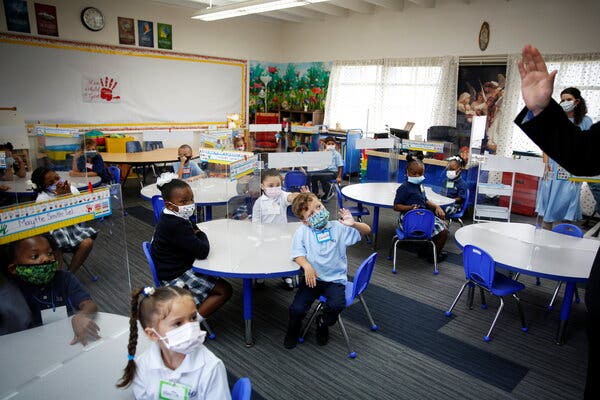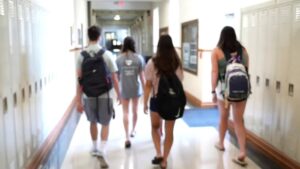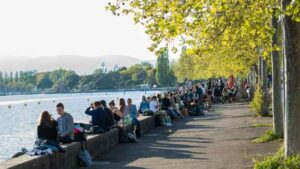The continuing fight over masks in schools, already a political tinderbox, has heated up even more: Federal officials announced that the Education Department had started investigations into five states, including Florida, where Gov. Ron DeSantis is cutting funds to school districts that defied his ban on mask mandates.
The U.S. Education Department’s Office for Civil Rights notified education leaders on Monday in Iowa, Oklahoma, South Carolina, Tennessee and Utah that their prohibitions against mask mandates may be restricting access for students who are protected under federal law from discrimination based on their disabilities.
In letters to state leaders, the acting assistant secretary for civil rights said the department would explore whether the prohibitions “may be preventing schools from meeting their legal obligations not to discriminate based on disability and from providing an equal educational opportunity to students with disabilities who are at heightened risk of severe illness from Covid-19.”
The battle has also escalated in Florida, where Mr. DeSantis, a Republican, made good on Monday on his threat to financially punish local school boards that required students to wear masks.
Florida is experiencing the worst outbreak of the coronavirus in the nation: Over the last seven days, an average of more than 16,000 people have been hospitalized each day, more than during any other period in the pandemic.
Richard Corcoran, the state education commissioner, said in a statement that his department would “fight” to protect the rights of parents to make health care decisions. “They know what is best for their children,” he wrote.
The penalty applies to two school districts — Alachua County and Broward County — that went ahead with mask mandates in defiance of the governor’s order. In response to the withholding of funds, Vickie L. Cartwright, the Broward County interim superintendent, said in a statement that “the health and safety of our students, teachers and staff continue to be our main priorities. As such, BCPS will continue to mandate masks.”
It remains unclear just how much the school boards will be affected, because the Biden administration has advised that any school district that is stripped of state funding over a backlash to pandemic precautions could use federal stimulus funds to make up the difference.
The investigations on the federal level follow the Biden administration’s promise to use the government’s muscle — including civil rights investigations and legal action — to intervene in states where governors and other policymakers have come out against mask mandates in public schools.
Miguel A. Cardona, Mr. Biden’s education secretary, has said he was particularly disturbed by prohibitions in places where the Delta variant is surging. He said that he has heard from desperate parents who fear sending their medically vulnerable children into schools that do not have universal masking.
In South Carolina, one of the targets of the federal investigation, the office of Gov. Henry McMaster, responded that the investigation was “another attempt by the Biden administration to force a radical liberal agenda on states and people who disagree with them.”
But there as in Florida, deep divisions exist within the state — not just between the state and the federal government. The South Carolina Department of Education said that the state superintendent “has repeatedly implored the legislature to reconsider” a recently passed proviso on mask mandates, which it said was being challenged in court.

The police in New Zealand are establishing checkpoints south of Auckland, the country’s largest city, to prevent people from moving illegally between regions with different levels of virus restrictions.
“The checkpoints on the outskirts of Auckland will be stopping vehicles and questioning drivers, ensuring there is no nonessential movement through the region,” said Andrew Coster, the country’s police commissioner, in a statement.
New Zealand has been in a strict national lockdown since Aug. 17, after a single case of the more contagious Delta variant was identified in the community. The country has since reported more than 600 cases, with 33 hospitalizations. Beginning Wednesday, most of New Zealand will move to a less severe Level 3 lockdown, while Auckland will remain under the heaviest level of restrictions for another two weeks.
Crossing the border between regions is permitted only under very limited circumstances, including for freight deliveries, to receive a dose of a Covid-19 vaccine or to take care of an ill person.
The lockdowns are another example of the challenges that the Delta variant has posed to countries that have followed a “Covid Zero” approach, aiming to eliminate the virus entirely in their territories and then keep it out with tight border rules. New Zealand committed to that plan early, and its success has allowed residents to live almost without restrictions for most of the pandemic. In total, the country has reported fewer than 3,500 cases and only 26 deaths.
North of Auckland, Maori tribes have been in consultation with the police about setting up community-run roadblocks to prevent Aucklanders from traveling into the Northland region after it relaxes restrictions later this week.
The community-run group Tai Tokerau Border Control, which uses the Maori name for the region, ran checkpoints alongside the police during last year’s lockdown. The group has been discouraged from doing so under the current restrictions because of the more contagious nature of the Delta variant, the police said.
“We’re being forced into the situation, because checking with our marae” — the Maori word for a community house — “and elders, they’re very concerned,” Reuben Taipari, a coordinator for the group, told the New Zealand news outlet Stuff, of the group’s desire to run their own roadblocks. “They’re almost demanding that we have to stand.”

After Hurricane Ida lashed Louisiana on Sunday, hospitals in the storm’s path were assessing building damage, bracing for storm-related injuries and determining how to continue Covid-19 care this week, all while being forced to run on generators for at least several days.
“Our hospital is at capacity,” said Ryan Cross, a spokesman for Our Lady of the Lake Regional Medical Center, which was busy treating its estimated 150 coronavirus patients Monday night, as well as people with storm-related injuries. “But we were very blessed that the storm did not deliver the impacts that we feared.”
The good fortune did not extend to several hospitals across the state, where a surge of Covid cases fueled by the Delta variant and low vaccination rates led to more than 2,400 people being hospitalized with coronavirus on Sunday, when Ida spurred evacuations in some health centers.
After a partial generator failure at Thibodaux Regional Health System in Lafourche Parish, staff had to manually push air in and out of patients’ lungs to keep them breathing while they were transferred to another floor in the hospital, according to the Louisiana Department of Health.
Oxygen supplies were also running critically low in several hospitals, with some having only one or two days of supply left as of Monday.
Ochsner Health, which operates Louisiana’s most extensive hospital network, evacuated 165 patients on Monday from three hospitals where roofs were damaged and water came down the walls, said Warner Thomas, the hospitals’ president and C.E.O.
“We have 10 days of fuel on site,” Mr. Thomas said, referring to the hospital generators. “More fuel is on its way. Water is on its way.”
Dr. Joseph Kanter, the chief health officer in Louisiana, said on Monday that major hospitals appeared to have suffered minor damage and a few smaller hospitals “suffered significant damage” and were evacuating on Monday.
“Hospitals will be busy next few days,” Dr. Kanter said on Twitter. “Avoid them if possible.”
Gov. John Bel Edwards said on Sunday that a significant number of residents who had not evacuated included hospitalized coronavirus patients.
“Evacuating these large hospitals is just not an option because there’s not any other hospitals with the capacity to take them,” he said.
And though the cleanup and repairs will stretch for weeks and months, as the state scrambles to restore power and water, the situation could have been much worse. At Lady of the Sea General Hospital in Lafourche Parish, the staff worked “tirelessly under extreme conditions” to care for patients said Karen Collins, the chief executive of the hospital. “Because of their efforts, all of our patients came through this event safely.”
Amanda Morris and Giulia Heyward contributed reporting.

Who wins and who loses when companies can hire from anywhere?
Some employees and freelancers who can work remotely will have vastly expanded opportunities and the possibility of significant increases in pay, but remote workers in general figure to face more competition.
One thing that seems unavoidable, research suggests, is an intensification of inequality.
A 1981 paper, “The Economics of Superstars,” described the impact of recording and broadcasting on the incomes of athletes and entertainers. As technology enabled individuals with specialized skills to reach a giant market, fewer stars captured more of the rewards.
Over time, the paper posited, many other professions would follow a similar pattern. A teacher’s income, for example, was traditionally limited by the number of students who could fit into one classroom.
But today on Udemy, an online learning platform, teachers like Chris Haroun have earned millions from courses they created, especially after Covid-19 lockdown pushed enrollments up. The vast majority of teachers on Udemy don’t come close to Mr. Haroun’s earnings, however.
A meaningful shift in the distribution of income can also be seen in platforms where remote instruction is more similar to traditional teaching. On Outschool, an online marketplace for virtual classes for children, hundreds of teachers earn more than $100,000 a year, and dozens earn over $230,000. Most Outschool teachers earn far less.
Remote work is also affecting more traditional institutions. Scott Galloway, a professor at N.Y.U.’s Stern School of Business, has said that “because all my classes are remote now, the school asked me, ‘Can you go from 160 — dictated by the size of Stern’s largest classroom — to 280?’ That’s 120 fewer seats for the other marketing professors to fight over.”
Similar dynamics can be seen in professions that were assumed to be inherently “in-person.” During the lockdowns, most fitness instructors were out of work. But a handful were thriving. By the end of 2020, Peloton had about four million members — equal to the number of gym patrons in New York State.
The company’s members were served by several dozen instructors who could live anywhere they liked. While most fitness instructors could not work at all, some Peloton instructors earned more than $500,000.



















